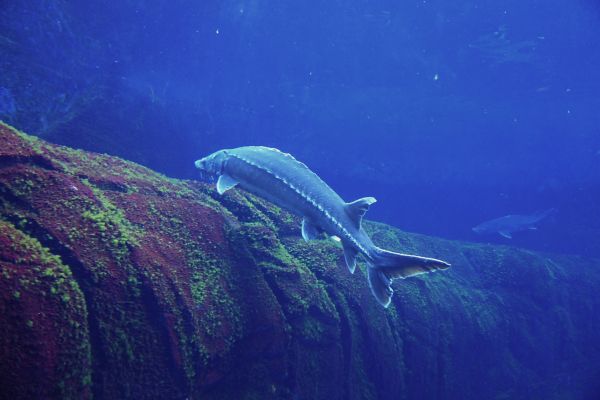Colourful hues
Get your best colours out to paint this goddess and make her come to life.
Get your best colours out to paint this goddess and make her come to life.
The second in the biome series is about marine biomes and the flora and fauna it supports.
In the next article on the series of biomes, we will look at marine or underwater biomes. A biome is a large region of Earth that has a certain climate and types of living organisms. Each biome’s plants and animals are characterised by traits that aid their survival in a particular biome — desert, tundra, tropical rainforest, grassland, savanna, freshwater, marine, to name a few. Each biome has several ecosystems.

The marine biome is the biggest in the world, and comprises five main oceans — the Atlantic, Arctic, Pacific, Indian, and Southern, as well as numerous smaller bays and gulfs. Marine regions are usually extremely salty.
Marine biomes are a part of aquatic biomes and are further divided into coral reefs, seas and ocean biomes, and estuaries biomes: essentially, all that involves the underwater world.
Coral reefs: They are widely distributed in warm, shallow waters and can be found as barriers along continents (the Great Barrier Reef off Australia, for instance), atolls, and fringing islands. As the name suggests, corals largely inhabit the reefs. They consist of tissues of animal polyp, and algae. Since reef waters tend to be poor in nutrients, these organisms obtain nutrients through the algae through photosynthesis, and also by extending tentacles to obtain plankton from the water. Besides corals, other fauna in the reefs includes several species of microorganisms, invertebrates, fishes, sea urchins, octopuses, among others.
Estuaries: Areas where freshwater streams or rivers merge with the ocean are known as estuaries. This mixing of waters with such different salt concentrations creates a unique ecosystem. Microflora such as algae, and macroflora, like marsh grass, seaweeds, and mangrove trees (only in the tropics), can be found here. Estuaries support a range of fauna, including a variety of worms, oysters, crabs, and waterfowl.
Seas and oceans: The largest of all the ecosystems, oceans, like ponds and lakes, are divided into separate zones: intertidal, pelagic, abyssal, and benthic, all of which have diverse species.
Where the ocean meets the land, is referred to as the intertidal zone. Sometimes it is submerged and at other times, exposed, as waves and tides come in and out. Where only the highest tides reach, there are only a few species of algae and molluscs. In those areas usually submerged during high tide, there is a more diverse array of algae and small animals, such as herbivorous snails, crabs, sea stars, and small fishes. At the bottom of the zone, which is only exposed during the lowest tides, many invertebrates, fishes, and seaweed exist.
The pelagic zone includes those waters further from the land, and is usually cold. The flora includes surface seaweeds while the fauna comprises multiple fish species, whales, dolphins, and more.
The benthic zone is the area below the pelagic zone, and its bottom consists of sand, slit, and/or dead organisms. Here temperature decreases as depth increases toward the abyssal zone, since light cannot penetrate through the deeper water. Fauna includes bacteria, fungi, sponges, sea anemones, worms, sea stars, and fishes, to name a few.
The deep ocean is the abyssal zone where the water is extremely cold, around 3° C. This zone is home to many species of invertebrates and fishes.
Navratri, Durga Puja,Dussehra … check out your knowledge of this festival with this crossword
No matter where in India you are, festive times are beginning soon. Try your hand at this puzzle and see how much you know about this particular celebration.
These animals are big, bulky, and absolutely brilliant! Watch this video to know more.

Here are a few famous celebrities from the field of sports. How many do you know?

Are you a delectable gulab jamun or a flavoursome payasam? Find out which Indian ‘mithai’ matches your personality.
Sugar, spice and everything nice – traditional Indian sweets have all this and more. You might have a favourite sweet for every occasion, but have you ever wondered which one of them matches your personality? Find out with this for-fun-only quiz.
It’s time to exercise your grey cells. Here are six questions to get you going. How many do you know the answers to?
Ready for a quick mental workout? Here’s a quiz to check your GK quotient.
You may recognise these famous authors born in September! Can you find their names in the grid?
September is the birth month of many illustrious authors. Horror and supernatural fiction author Stephen King, crime novelist Agatha Christie, Bengali writer Sarat Chandra Chattopadhyay to children’s authors Enid Blyton and Roald Dahl…between them, they’ve got a lot of genres covered.
Can you find the last names of these authors (mentioned along with their birth date and one of their famous titles) in the word grid?
(Click to enlarge the pictures)
How much do you know about the world of pre-historic creatures? Solve this crossword to find out.
Millions of years ago, the creatures that roamed the earth were nothing like the wildlife we see today. They were large, fearsome and ruled the planet without interference from humans.
Solve this crossword to test your knowledge about some pre-historic creatures.
We all have 32 teeth, but do you know what the teeth is made up of? Try your hand at this game to find out.
The human teeth function to mechanically break down food by cutting and crushing them in preparation for swallowing and digesting. Ever wondered what makes it work? What does it look like inside?
The enamel is the tooth’s thin outer covering. It is a tough shell and the hardest tissue in the human body.
The dentin makes up the largest part of the tooth. Although it is not as tough as enamel, it is also very hard.
The innermost part of the tooth is called pulp, and it is where the blood supply and the nerve endings of the tooth can be found. The pulp is protected by the dentin.
Also called the gingiva, the gums are the tissues of the upper and lower jaws that surrounds the teeth’s base.
The periodontal ligament, commonly known as the PDL, is a soft connective tissue between the inner wall of the alveolar socket and the teeth’s roots.
The nerves and blood vessels are located in the pulp and run through the tooth in the root canal.
The lateral canal extends from the main canal to the periodontal ligament. more frequently in the body of the root than in the base.
Based on what you have read so far, can you drag and drop the parts of the tooth into the right boxes?